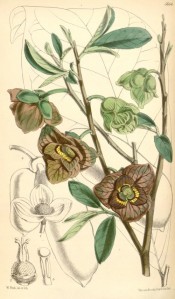Asimina triloba Dun.
Fully hardy deciduous shrub or small tree with large obovate leaves, turning yellow in autumn, and cup-shaped flowers in spring, followed by edible, ovoid, bottle-shaped, yellow-brown fruit. To 6m. [RHSE, Hortus].
Horticultural & Botanical History
One of the first American plants to be introduced into Britain by Peter Collinson in 1736. [Hilliers’]. Both Paxton’s and Johnson’s Dictionary describe it as a Chinese plant, introduced in 1822. ‘A very curious plant, and rare in cultivation, a native of the banks of streams in the Middle, Southern, and Western States of N. America, where it forms a small tree, fifteen to thirty feet high, flowering in March and April; and bearing in Autumn a yellow, fragrant, fleshy, eatable fruit called both “Custard Apple,” and ” Papaw” in the States, (though equally widely different from the fruit of the Custard Apple proper, Anona reticidata, and of the true Papaw, Carica Papaya.) “Asiminier,” was the name applied to it by the early French colonists of America. Asimina triloba was introduced into England by Peter Collinson in 1736, and probably old trees of it may still linger in Botanic and other Gardens. The plate here given is from plants raised from seeds presented to the Royal Gardens by Professor A. Gray, of Cambridge, U.S.A., which were trained against a wall, and flowered in June of the present year.’ [BM t.5854/1870].
History at Camden Park
Listed in all published catalogues [T.58/1843]. Probably introduced to assess its potential as a fruit tree under Camden conditions.
Notes
See also Carica papaya L., the Pawpaw of Asia.
Published Feb 23, 2009 - 03:39 PM | Last updated Jul 14, 2010 - 11:34 AM
| Family | Annonaceae |
|---|---|
| Category | |
| Region of origin | Eastern USA |
| Synonyms |
|
| Common Name | Asiminier, Pawpaw |
| Name in the Camden Park Record | Anona triloba |
| Confidence level | high |


